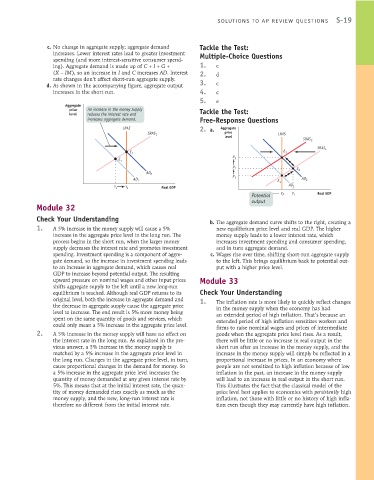Page 865 - Krugmans Economics for AP Text Book_Neat
P. 865
S-19
SOLUTIONS TO AP REVIEW QUESTIONS
c. No change in aggregate supply; aggregate demand Tackle the Test:
increases. Lower interest rates lead to greater investment Multiple-Choice Questions
spending (and more interest-sensitive consumer spend-
ing). Aggregate demand is made up of C + I + G + 1. c
(X − IM), so an increase in I and C increases AD. Interest 2. d
rate changes don’t affect short-run aggregate supply. 3.
d. As shown in the accompanying figure, aggregate output c
increases in the short run. 4. c
5. e
Aggregate
price An increase in the money supply Tackle the Test:
level reduces the interest rate and
increases aggregate demand. Free-Response Questions
LRAS 2. a. Aggregate
SRAS 1 price LRAS
level
SRAS 2
SRAS 1
E 2 E 3
P 3
E 1
P 2
E 2
AD 2
P 1
AD 1 AD 2
E 1
AD 1
Y 1 Y 2 Real GDP
Real GDP
Potential Y P Y 1
output
Module 32
Check Your Understanding b. The aggregate demand curve shifts to the right, creating a
1. A 5% increase in the money supply will cause a 5% new equilibrium price level and real GDP. The higher
increase in the aggregate price level in the long run. The money supply leads to a lower interest rate, which
process begins in the short run, when the larger money increases investment spending and consumer spending,
supply decreases the interest rate and promotes investment and in turn aggregate demand.
spending. Investment spending is a component of aggre- c. Wages rise over time, shifting short-run aggregate supply
gate demand, so the increase in investment spending leads to the left. This brings equilibrium back to potential out-
to an increase in aggregate demand, which causes real put with a higher price level.
GDP to increase beyond potential output. The resulting
Module 33
upward pressure on nominal wages and other input prices
shifts aggregate supply to the left until a new long-run
equilibrium is reached. Although real GDP returns to its Check Your Understanding
original level, both the increase in aggregate demand and 1. The inflation rate is more likely to quickly reflect changes
the decrease in aggregate supply cause the aggregate price in the money supply when the economy has had
level to increase. The end result is 5% more money being
an extended period of high inflation. That’s because an
spent on the same quantity of goods and services, which extended period of high inflation sensitizes workers and
could only mean a 5% increase in the aggregate price level. firms to raise nominal wages and prices of intermediate
2. A 5% increase in the money supply will have no effect on goods when the aggregate price level rises. As a result,
the interest rate in the long run. As explained in the pre- there will be little or no increase in real output in the
vious answer, a 5% increase in the money supply is short run after an increase in the money supply, and the
matched by a 5% increase in the aggregate price level in increase in the money supply will simply be reflected in a
the long run. Changes in the aggregate price level, in turn, proportional increase in prices. In an economy where
cause proportional changes in the demand for money. So people are not sensitized to high inflation because of low
a 5% increase in the aggregate price level increases the inflation in the past, an increase in the money supply
quantity of money demanded at any given interest rate by will lead to an increase in real output in the short run.
5%. This means that at the initial interest rate, the quan- This illustrates the fact that the classical model of the
tity of money demanded rises exactly as much as the price level best applies to economies with persistently high
money supply, and the new, long-run interest rate is inflation, not those with little or no history of high infla-
therefore no different from the initial interest rate. tion even though they may currently have high inflation.

